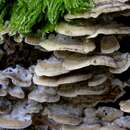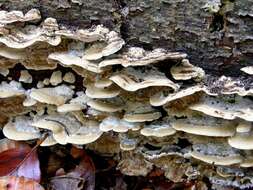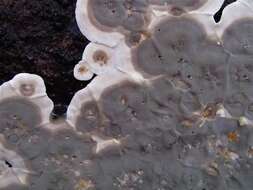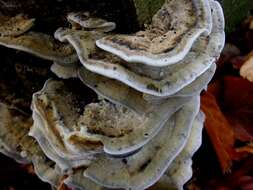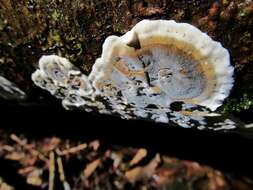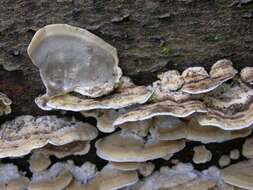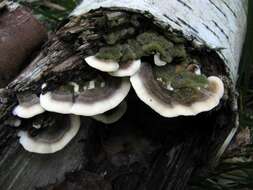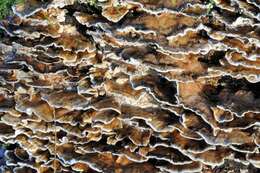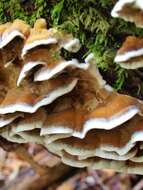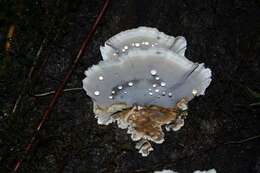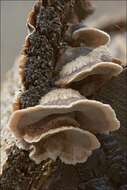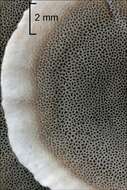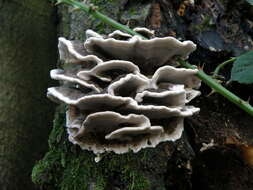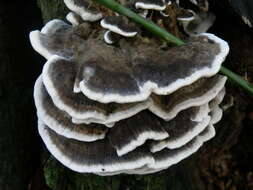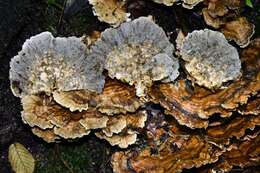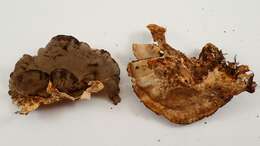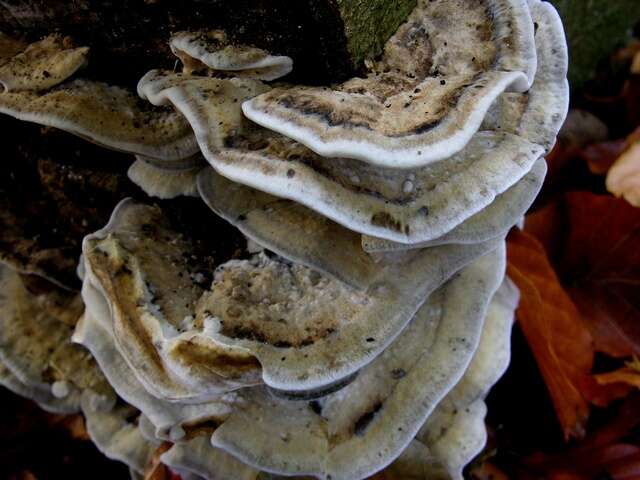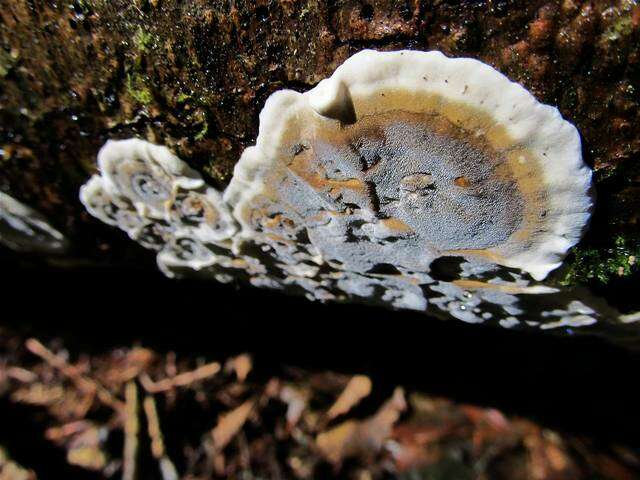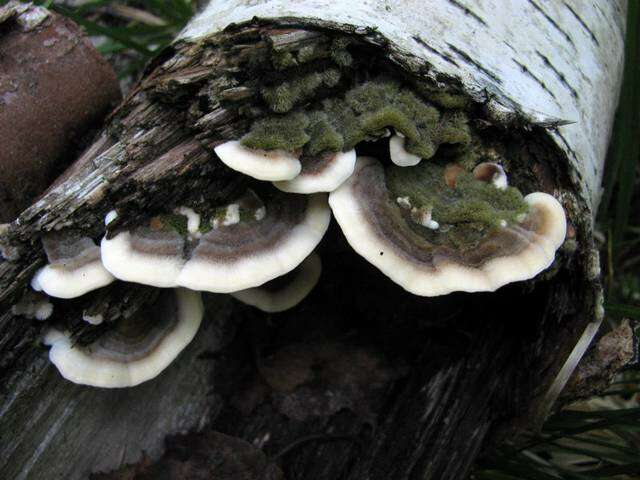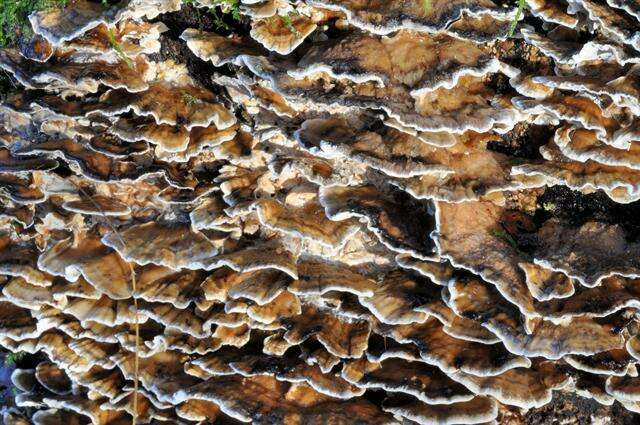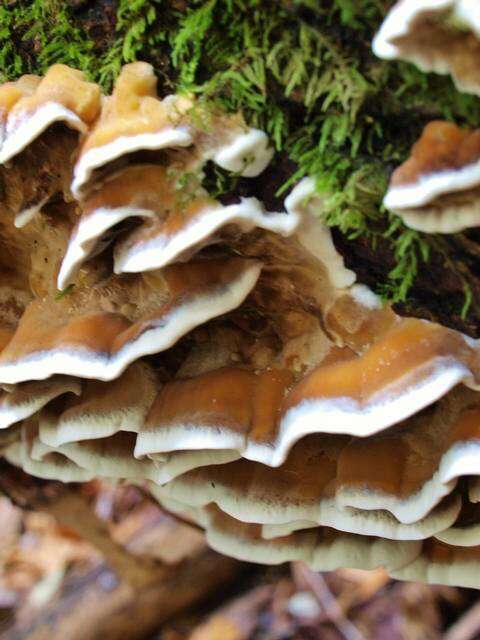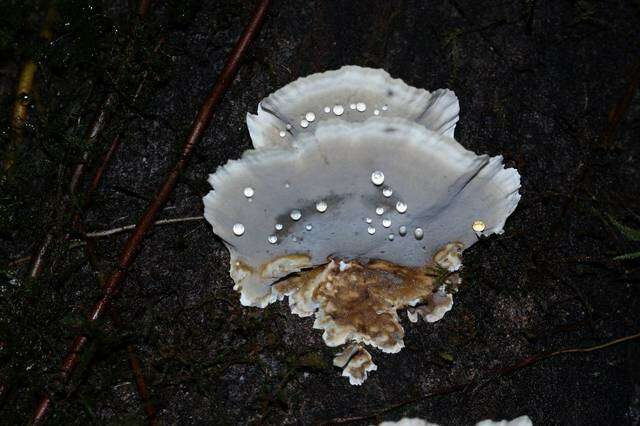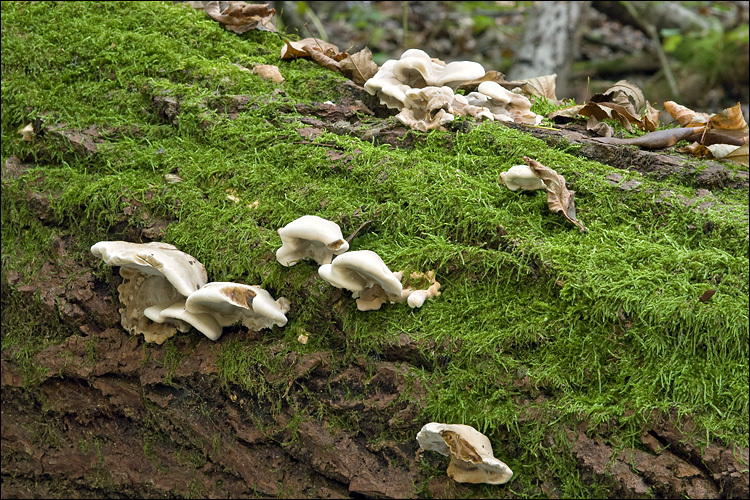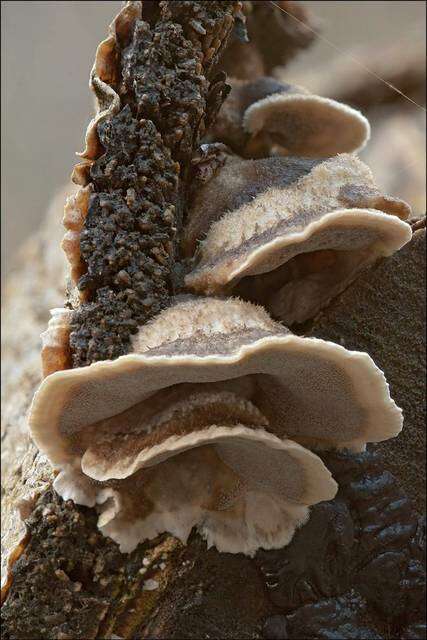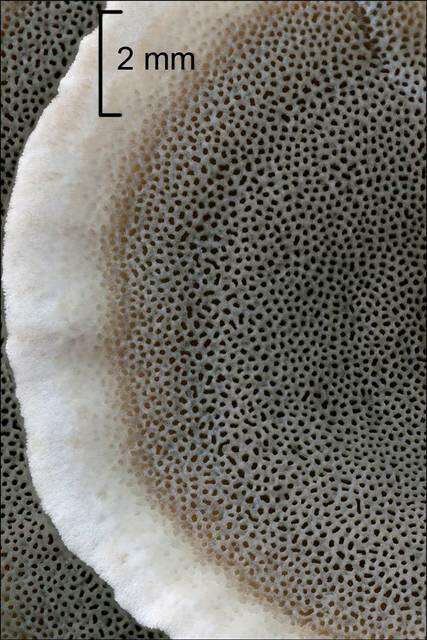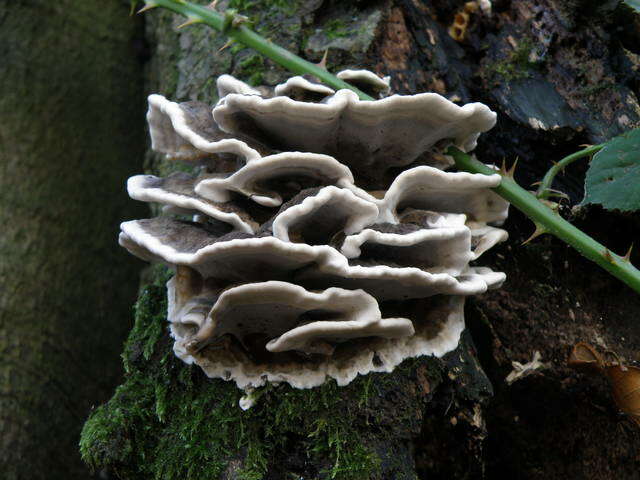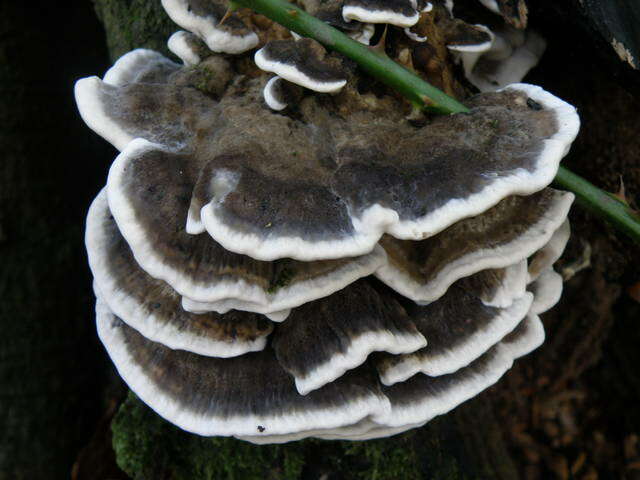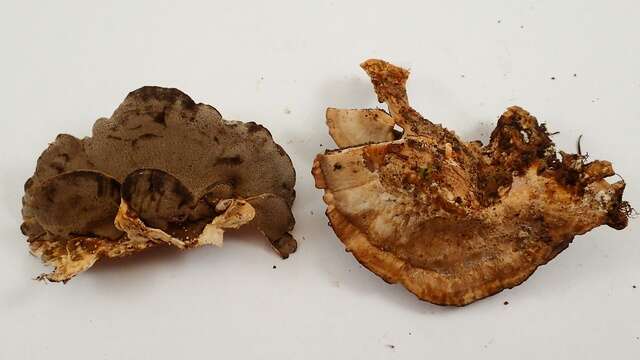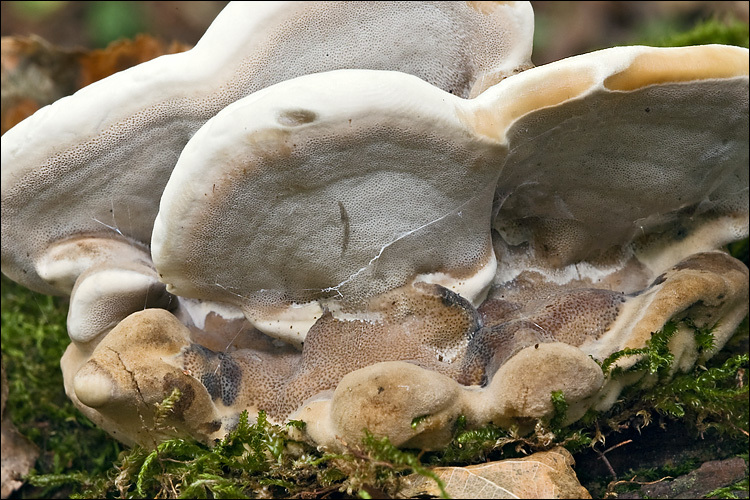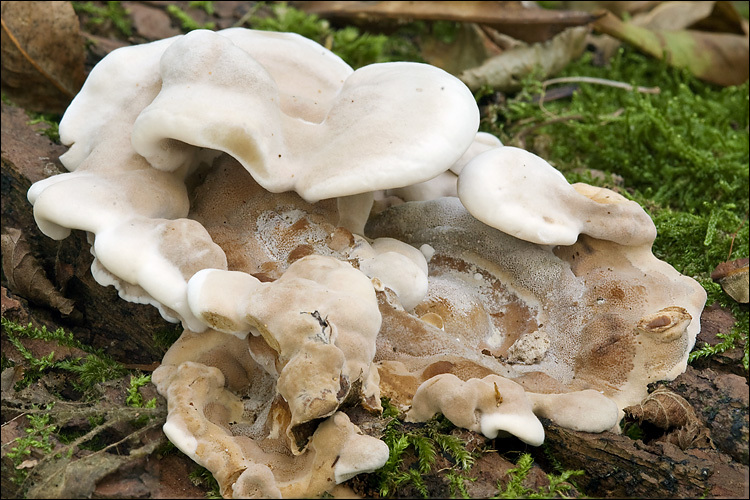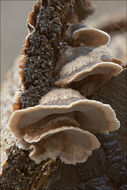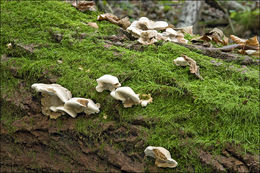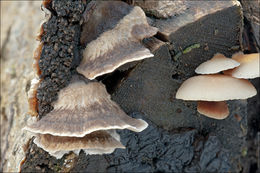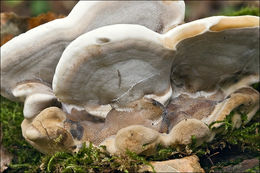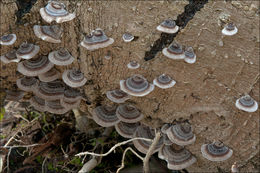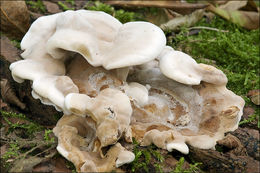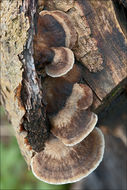-
Hobro Skov, Jylland, Danmark
-
Mushroom Observer Image 134752: Bjerkandera adusta (Willd.) P. Karst.
-
Hobro Skov, Jylland, Danmark
-
Mushroom Observer Image 134753: Bjerkandera adusta (Willd.) P. Karst.
-
Hobro Skov, Jylland, Danmark
-
Mushroom Observer Image 134756: Bjerkandera adusta (Willd.) P. Karst.
-
Hobro Skov, Jylland, Danmark
-
Mushroom Observer Image 163315: Bjerkandera adusta (Willd.) P. Karst.
-
Fussingø Vandmølle V.f. Randers, Danmark
-
Mushroom Observer Image 180760: Bjerkandera adusta (Willd.) P. Karst.
-
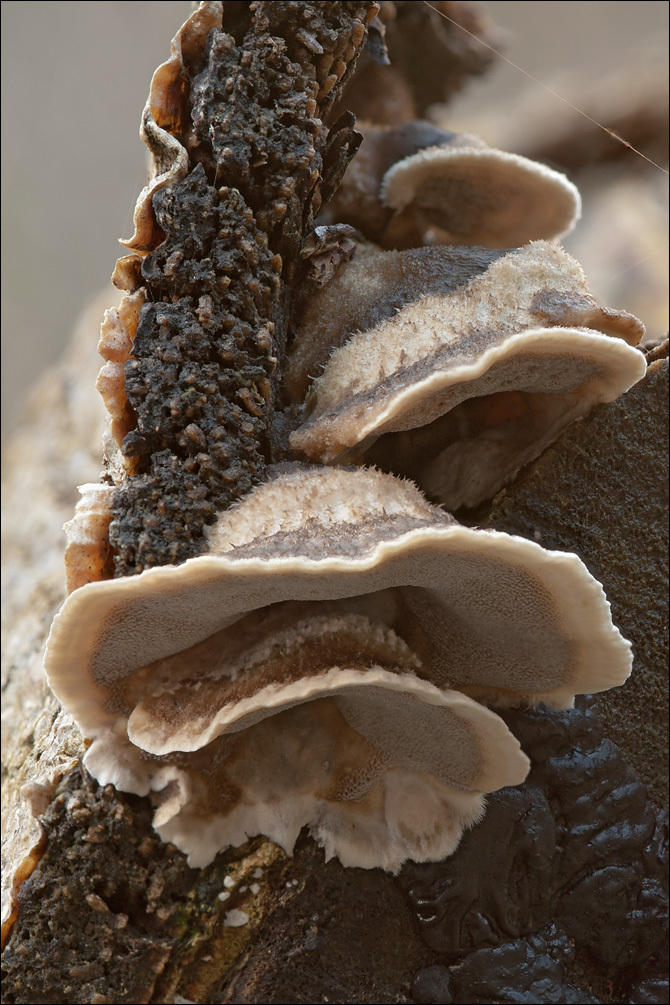
Slo.: osmojena bjerkandera - syn.: Boletus crispus Pers. - Habitat: alpine valley, river bank, locally almost flat terrain, calcareous ground, river bank vegetation mostly consisting of Salix eleagnos, Picea abies and some Fagus sylvatica; humid air and ground, partly sunny, exposed to direct rain; average precipitations ~ 3.000 mm/year, average temperature 7-9 deg C, elevation 525 m (1.720 feet), alpine phytogeographical region. - Substratum: dead wood, a stump of cut down Salix eleagnos in its late initial phase of disintegration. - Comments: There exist two species of the genus Bjerkandera growing in Europe and also in Slovenia: Bjerkandera adusta and Bjerkandera fumosa. Both have very variable and irregular habitus and can be found pileate, effuse reflexed and also totally resupinate. Bjerkandera adusta is more common and can be distinguished from Bjerkandera fumosa by its very, very small more or less angular pores (5-7/mm), darker gray pore surface with pale margin and smaller spores. But distinguishing is not always easy. Bjerkandera adusta can be found during the whole year but it sporulates only at temperatures below 10 deg C (Ref.:4). So, one can hope to get spore print only during colder seasons of my country. Generally in the literature the pilei are described as azonate or only weakly zonate, however when they are very young this apparently doesn't hold (see Fig.4). - Growing in imbricate groups of several fruit bodies; pilei 1.2 - 2.8 cm across, trama pale brown, corky-fibrous (cannot be chewed over but can be nicely cut with a razor), up to 4.5 mm thick, pore layer dark-grey and distinctly darker then trama, about 1 mm thick; stipe absent; taste mild, slightly unpleasant but not bitter; smell on sour earth similar to Trametes versicolor; SP faint, whitish. - Spores smooth. Dimensions: 4.1 [4.5 ; 4.7] 5.1 x 2.6 [2.9 ; 3] 3.4 microns; Q = 1.3 [1.5 ; 1.6] 1.8; N = 37; C = 95%; Me = 4.6 x 3 microns; Qe = 1.6. Olympus CH20, NEA 100x/1.25, magnification 1.000 x, oil; in water, live material. AmScope MA500 digital camera. - Herbarium: Mycotheca and lichen herbarium (LJU-Li) of Slovenian Forestry Institute, Vena pot 2, Ljubljana, Index Herbariorum LJF - Ref.: (1) J. Breitenbach, F. Kraenzlin, Eds., Fungi of Switzerland, Vol.2. Verlag Mykologia (1986), p 268. (2) M. Bon, Parey's Buch der Pilze, Kosmos (2005), p 316. (3) L. Ryvarden, R.L. Gilbertson, European Polypores, part 1., Synopsis Fungorum 7., Fungiflora A/S (1993), p 168. (4) G.J. Krieglsteiner (Hrsg.), Die Grosspilze Baden-Wrttembergs, Band 1., Ulmer (2000), p 486. (5) A. Bernicchia, S.P.Gorjon, Cortitiaceaes.i., Fungi Europaei Vol.12., Edizioni Candusso (2010), p 139.
-
Mushroom Observer Image 305389: Bjerkandera adusta (Willd.) P. Karst.
-
Slo.: okata bjerkandera - Habitat: Light mixed wood with some ground vegetation, flysh bedrock, flat terrain, mostly in shade, average precipitations ~3.000 mm/year, average temperature 8-10 deg C, elevation 440 m (1.450 feet), alpine phytogeographical region. - Substratum: fallen, to some degree rotten, trunk of a deciduous tree, overgrown with mosses. - Comment: Many fruit bodies. These are young specimens. Odor 'mushroomy'. Basidiocarps annual. Spores were not obtained. Thanks to Irene Andersson, MushroomObserver.com for identification. Identification is not completely certain. - Ref.: (1) Personal communication Irene Andersson, MushroomObserver.com (2) A.Bernicchia, Polyporaceae s.l., Fungi Europaei 10, Edizioni Candusso (2005), p 141 (3) D.Arora, Mushrooms Demystified, Ten Speed Press, Berkeley (1986), p 596 (4) http://www.naturspaziergang.de/Pilze.htm (5) http://www.bioimages.org.uk/html/r157182.htm
-
Mushroom Observer Image 499180: Bjerkandera adusta (Willd.) P. Karst.
-
Mushroom Observer Image 499184: Bjerkandera adusta (Willd.) P. Karst.
-
Mushroom Observer Image 64486: Bjerkandera adusta (Willd.) P. Karst.
-
Mushroom Observer Image 64487: Bjerkandera adusta (Willd.) P. Karst.
-
Mushroom Observer Image 740618: Bjerkandera adusta (Willd.) P. Karst.
-
Mushroom Observer Image 991408: Bjerkandera adusta (Willd.) P. Karst.
-
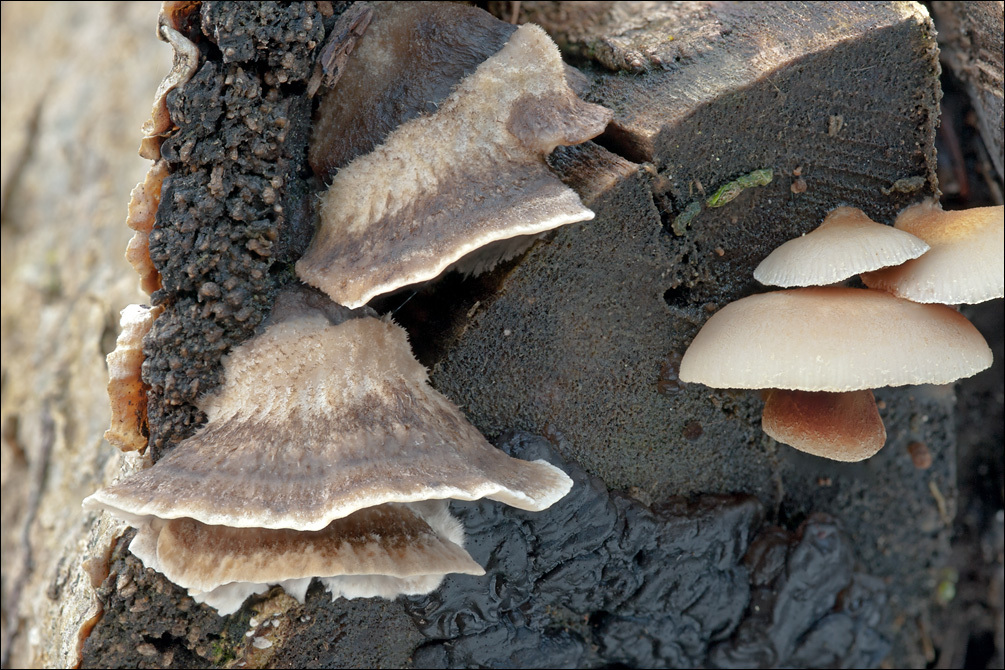
Slo.: osmojena bjerkandera - syn.: Boletus crispus Pers. - Habitat: alpine valley, river bank, locally almost flat terrain, calcareous ground, river bank vegetation mostly consisting of Salix eleagnos, Picea abies and some Fagus sylvatica; humid air and ground, partly sunny, exposed to direct rain; average precipitations ~ 3.000 mm/year, average temperature 7-9 deg C, elevation 525 m (1.720 feet), alpine phytogeographical region. - Substratum: dead wood, a stump of cut down Salix eleagnos in its late initial phase of disintegration. - Comments: There exist two species of the genus Bjerkandera growing in Europe and also in Slovenia: Bjerkandera adusta and Bjerkandera fumosa. Both have very variable and irregular habitus and can be found pileate, effuse reflexed and also totally resupinate. Bjerkandera adusta is more common and can be distinguished from Bjerkandera fumosa by its very, very small more or less angular pores (5-7/mm), darker gray pore surface with pale margin and smaller spores. But distinguishing is not always easy. Bjerkandera adusta can be found during the whole year but it sporulates only at temperatures below 10 deg C (Ref.:4). So, one can hope to get spore print only during colder seasons of my country. Generally in the literature the pilei are described as azonate or only weakly zonate, however when they are very young this apparently doesn't hold (see Fig.4). - Growing in imbricate groups of several fruit bodies; pilei 1.2 - 2.8 cm across, trama pale brown, corky-fibrous (cannot be chewed over but can be nicely cut with a razor), up to 4.5 mm thick, pore layer dark-grey and distinctly darker then trama, about 1 mm thick; stipe absent; taste mild, slightly unpleasant but not bitter; smell on sour earth similar to Trametes versicolor; SP faint, whitish. - Spores smooth. Dimensions: 4.1 [4.5 ; 4.7] 5.1 x 2.6 [2.9 ; 3] 3.4 microns; Q = 1.3 [1.5 ; 1.6] 1.8; N = 37; C = 95%; Me = 4.6 x 3 microns; Qe = 1.6. Olympus CH20, NEA 100x/1.25, magnification 1.000 x, oil; in water, live material. AmScope MA500 digital camera. - Herbarium: Mycotheca and lichen herbarium (LJU-Li) of Slovenian Forestry Institute, Vena pot 2, Ljubljana, Index Herbariorum LJF - Ref.: (1) J. Breitenbach, F. Kraenzlin, Eds., Fungi of Switzerland, Vol.2. Verlag Mykologia (1986), p 268. (2) M. Bon, Parey's Buch der Pilze, Kosmos (2005), p 316. (3) L. Ryvarden, R.L. Gilbertson, European Polypores, part 1., Synopsis Fungorum 7., Fungiflora A/S (1993), p 168. (4) G.J. Krieglsteiner (Hrsg.), Die Grosspilze Baden-Wrttembergs, Band 1., Ulmer (2000), p 486. (5) A. Bernicchia, S.P.Gorjon, Cortitiaceaes.i., Fungi Europaei Vol.12., Edizioni Candusso (2010), p 139.
-
Slo.: okata bjerkandera - Habitat: Light mixed wood with some ground vegetation, flysh bedrock, flat terrain, mostly in shade, average precipitations ~3.000 mm/year, average temperature 8-10 deg C, elevation 440 m (1.450 feet), alpine phytogeographical region. - Substratum: fallen, to some degree rotten, trunk of a deciduous tree, overgrown with mosses. - Comment: Many fruit bodies. These are young specimens. Odor 'mushroomy'. Basidiocarps annual. Spores were not obtained. Thanks to Irene Andersson, MushroomObserver.com for identification. Identification is not completely certain. - Ref.: (1) Personal communication Irene Andersson, MushroomObserver.com (2) A.Bernicchia, Polyporaceae s.l., Fungi Europaei 10, Edizioni Candusso (2005), p 141 (3) D.Arora, Mushrooms Demystified, Ten Speed Press, Berkeley (1986), p 596 (4) http://www.naturspaziergang.de/Pilze.htm (5) http://www.bioimages.org.uk/html/r157182.htm
-
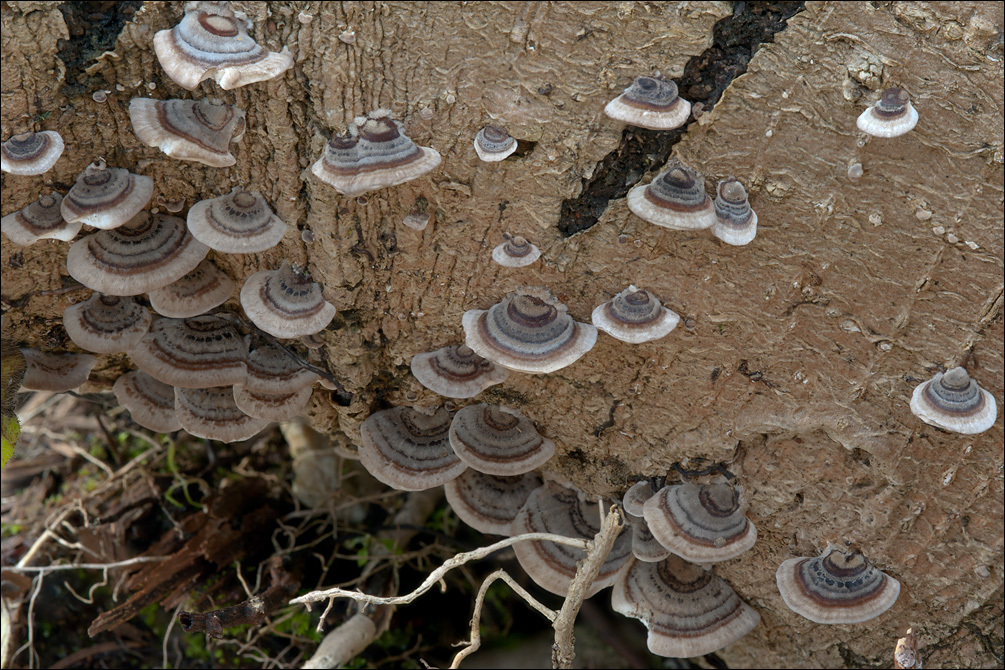
Slo.: osmojena bjerkandera - syn.: Boletus crispus Pers. - Comment: These were very young fruit bodies, with still white or pale gray pore surface, with very, very small still developing pores. - Habitat: alpine valley, river bank, locally almost flat terrain, calcareous ground, river bank vegetation mostly consisting of Salix eleagnos, Picea abies and some Fagus sylvatica; humid air and ground, partly sunny, exposed to direct rain; average precipitations ~ 3.000 mm/year, average temperature 7-9 deg C, elevation 525 m (1.720 feet), alpine phytogeographical region. - Substratum: dead wood, a stump of cut down Salix eleagnos in its late initial phase of disintegration. - Comments: There exist two species of the genus Bjerkandera growing in Europe and also in Slovenia: Bjerkandera adusta and Bjerkandera fumosa. Both have very variable and irregular habitus and can be found pileate, effuse reflexed and also totally resupinate. Bjerkandera adusta is more common and can be distinguished from Bjerkandera fumosa by its very, very small more or less angular pores (5-7/mm), darker gray pore surface with pale margin and smaller spores. But distinguishing is not always easy. Bjerkandera adusta can be found during the whole year but it sporulates only at temperatures below 10 deg C (Ref.:4). So, one can hope to get spore print only during colder seasons of my country. Generally in the literature the pilei are described as azonate or only weakly zonate, however when they are very young this apparently doesn't hold (see Fig.4). - Growing in imbricate groups of several fruit bodies; pilei 1.2 - 2.8 cm across, trama pale brown, corky-fibrous (cannot be chewed over but can be nicely cut with a razor), up to 4.5 mm thick, pore layer dark-grey and distinctly darker then trama, about 1 mm thick; stipe absent; taste mild, slightly unpleasant but not bitter; smell on sour earth similar to Trametes versicolor; SP faint, whitish. - Spores smooth. Dimensions: 4.1 [4.5 ; 4.7] 5.1 x 2.6 [2.9 ; 3] 3.4 microns; Q = 1.3 [1.5 ; 1.6] 1.8; N = 37; C = 95%; Me = 4.6 x 3 microns; Qe = 1.6. Olympus CH20, NEA 100x/1.25, magnification 1.000 x, oil; in water, live material. AmScope MA500 digital camera. - Herbarium: Mycotheca and lichen herbarium (LJU-Li) of Slovenian Forestry Institute, Vena pot 2, Ljubljana, Index Herbariorum LJF - Ref.: (1) J. Breitenbach, F. Kraenzlin, Eds., Fungi of Switzerland, Vol.2. Verlag Mykologia (1986), p 268. (2) M. Bon, Parey's Buch der Pilze, Kosmos (2005), p 316. (3) L. Ryvarden, R.L. Gilbertson, European Polypores, part 1., Synopsis Fungorum 7., Fungiflora A/S (1993), p 168. (4) G.J. Krieglsteiner (Hrsg.), Die Grosspilze Baden-Wrttembergs, Band 1., Ulmer (2000), p 486. (5) A. Bernicchia, S.P.Gorjon, Cortitiaceaes.i., Fungi Europaei Vol.12., Edizioni Candusso (2010), p 139.
-
Slo.: okata bjerkandera - Habitat: Light mixed wood with some ground vegetation, flysh bedrock, flat terrain, mostly in shade, average precipitations ~3.000 mm/year, average temperature 8-10 deg C, elevation 440 m (1.450 feet), alpine phytogeographical region. - Substratum: fallen, to some degree rotten, trunk of a deciduous tree, overgrown with mosses. - Comment: Many fruit bodies. These are young specimens. Odor 'mushroomy'. Basidiocarps annual. Spores were not obtained. Thanks to Irene Andersson, MushroomObserver.com for identification. Identification is not completely certain. - Ref.: (1) Personal communication Irene Andersson, MushroomObserver.com (2) A.Bernicchia, Polyporaceae s.l., Fungi Europaei 10, Edizioni Candusso (2005), p 141 (3) D.Arora, Mushrooms Demystified, Ten Speed Press, Berkeley (1986), p 596 (4) http://www.naturspaziergang.de/Pilze.htm (5) http://www.bioimages.org.uk/html/r157182.htm
-
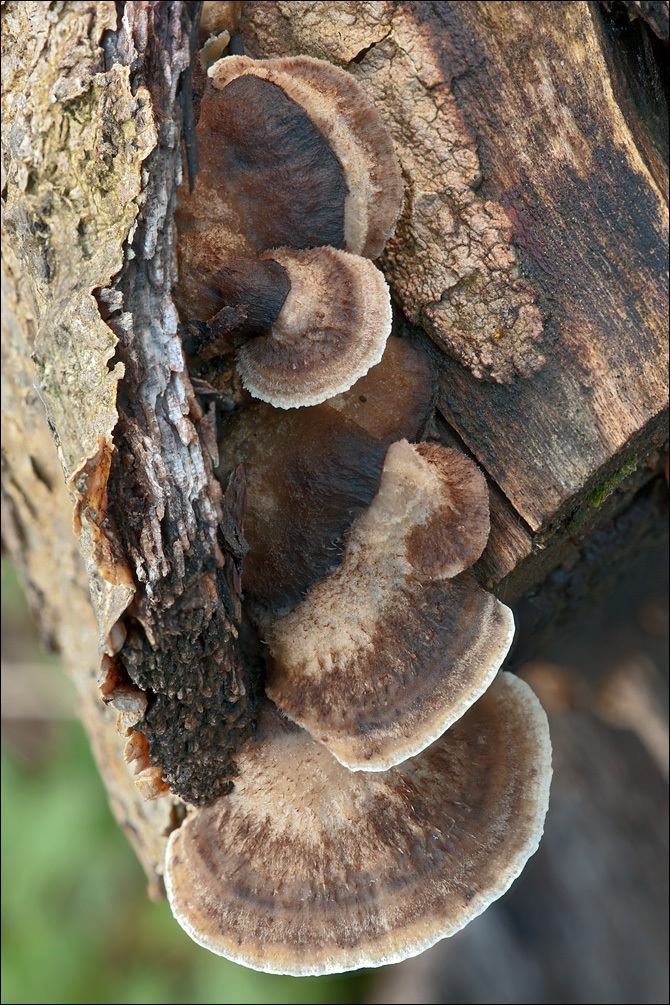
Slo.: osmojena bjerkandera - syn.: Boletus crispus Pers. - Habitat: alpine valley, river bank, locally almost flat terrain, calcareous ground, river bank vegetation mostly consisting of Salix eleagnos, Picea abies and some Fagus sylvatica; humid air and ground, partly sunny, exposed to direct rain; average precipitations ~ 3.000 mm/year, average temperature 7-9 deg C, elevation 525 m (1.720 feet), alpine phytogeographical region. - Substratum: dead wood, a stump of cut down Salix eleagnos in its late initial phase of disintegration. - Comments: There exist two species of the genus Bjerkandera growing in Europe and also in Slovenia: Bjerkandera adusta and Bjerkandera fumosa. Both have very variable and irregular habitus and can be found pileate, effuse reflexed and also totally resupinate. Bjerkandera adusta is more common and can be distinguished from Bjerkandera fumosa by its very, very small more or less angular pores (5-7/mm), darker gray pore surface with pale margin and smaller spores. But distinguishing is not always easy. Bjerkandera adusta can be found during the whole year but it sporulates only at temperatures below 10 deg C (Ref.:4). So, one can hope to get spore print only during colder seasons of my country. Generally in the literature the pilei are described as azonate or only weakly zonate, however when they are very young this apparently doesn't hold (see Fig.4). - Growing in imbricate groups of several fruit bodies; pilei 1.2 - 2.8 cm across, trama pale brown, corky-fibrous (cannot be chewed over but can be nicely cut with a razor), up to 4.5 mm thick, pore layer dark-grey and distinctly darker then trama, about 1 mm thick; stipe absent; taste mild, slightly unpleasant but not bitter; smell on sour earth similar to Trametes versicolor; SP faint, whitish. - Spores smooth. Dimensions: 4.1 [4.5 ; 4.7] 5.1 x 2.6 [2.9 ; 3] 3.4 microns; Q = 1.3 [1.5 ; 1.6] 1.8; N = 37; C = 95%; Me = 4.6 x 3 microns; Qe = 1.6. Olympus CH20, NEA 100x/1.25, magnification 1.000 x, oil; in water, live material. AmScope MA500 digital camera. - Herbarium: Mycotheca and lichen herbarium (LJU-Li) of Slovenian Forestry Institute, Vena pot 2, Ljubljana, Index Herbariorum LJF - Ref.: (1) J. Breitenbach, F. Kraenzlin, Eds., Fungi of Switzerland, Vol.2. Verlag Mykologia (1986), p 268. (2) M. Bon, Parey's Buch der Pilze, Kosmos (2005), p 316. (3) L. Ryvarden, R.L. Gilbertson, European Polypores, part 1., Synopsis Fungorum 7., Fungiflora A/S (1993), p 168. (4) G.J. Krieglsteiner (Hrsg.), Die Grosspilze Baden-Wrttembergs, Band 1., Ulmer (2000), p 486. (5) A. Bernicchia, S.P.Gorjon, Cortitiaceaes.i., Fungi Europaei Vol.12., Edizioni Candusso (2010), p 139.

